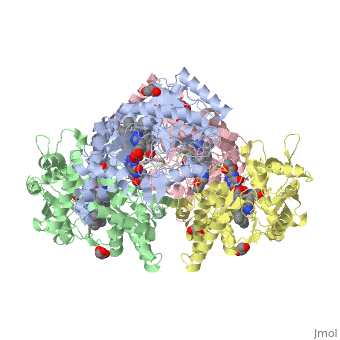Nos1
From Proteopedia
(Difference between revisions)
| Line 5: | Line 5: | ||
== Location == | == Location == | ||
| - | The human gene NOS1, found on chromosome 12, encodes for a nitric oxide synthase. Nitric oxide synthases consume L-arginine to produce nitric oxide. The chemical equation is shown below. | + | The human gene NOS1, found on chromosome 12, encodes for a nitric oxide synthase which is ubiquitously expressed. Nitric oxide synthases consume L-arginine to produce nitric oxide. The chemical equation is shown below. |
2 L-arginine + 3 NADPH + 4 O(2) = 2 L- citrulline + 2 nitric oxide + 3 NADP(+) + 4 H(2)O | 2 L-arginine + 3 NADPH + 4 O(2) = 2 L- citrulline + 2 nitric oxide + 3 NADP(+) + 4 H(2)O | ||
| - | Nitric oxide is used in a wide variety of processes. A few examples of molecular processes include heme binding, NADP binding, calcium signaling, and oxidation-reduction reactions. Biological examples include regulation of cardiac muscle contraction, blood coagulation, aging, and regulation of neurogenesis. There are three known isoforms known for NOS1 in humans produced by alternative splicing. | + | Nitric oxide is used in a wide variety of processes. A few examples of molecular processes include heme binding, NADP binding, calcium signaling, and oxidation-reduction reactions. Biological examples include regulation of cardiac muscle contraction, blood coagulation, aging, and regulation of neurogenesis. There are three known isoforms known for NOS1 in humans produced by alternative splicing, as well as four transcript variants for NOS1. The alternatively-spliced isoforms are reffered to as neuronal NOS (nNOS or NOS1), endothelial NOS (eNOS or NOS3), and cytokine-inducible NOS (iNOS or NOS2). Moderate expression of NOS1 has been observed in skeletal muscle, brain, testicular, lung, and kidney tissue. Low expression has been observed in heart, adrenal gland, and retinal tissues. |
Revision as of 18:55, 12 April 2016
Your Heading Here (maybe something like 'Structure')
| |||||||||||
References
- ↑ Hanson, R. M., Prilusky, J., Renjian, Z., Nakane, T. and Sussman, J. L. (2013), JSmol and the Next-Generation Web-Based Representation of 3D Molecular Structure as Applied to Proteopedia. Isr. J. Chem., 53:207-216. doi:http://dx.doi.org/10.1002/ijch.201300024
- ↑ Herraez A. Biomolecules in the computer: Jmol to the rescue. Biochem Mol Biol Educ. 2006 Jul;34(4):255-61. doi: 10.1002/bmb.2006.494034042644. PMID:21638687 doi:10.1002/bmb.2006.494034042644

